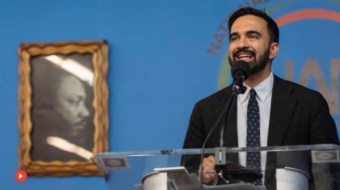
Arkansas Republican Sen. Tom Cotton recently proposed legislation that would deny federal funding to schools that in any way used The New York Times’ controversial 1619 project in its curriculum. The series explores the history of the United States through the lens of slavery, premised on the fact that accounts of slavery have not been expansively, roundly, and fully incorporated into accounts of U.S. history, particularly in its earliest stages. Nikole Hannah-Jones, the project’s creator, has been awarded a Pulitzer Prize for her commentary on the series, and the Pulitzer Center and the Times have since collaborated to create a curriculum based on the project which schools can now adopt.
This last prospect upsets Cotton for reasons that aren’t entirely clear. Does he not want children in America to confront the horrors of an American institution that inflicted untold violence on other human beings, subjecting them to being owned, having their labor exploited, and being denied any human rights or protection under the law?
I guess not. What we do know, at a minimum, is that Cotton wants us all, including the generations that come after us, to understand slavery in the United States as a “necessary evil.” He told the Arkansas Democrat-Gazette, “As the Founding Fathers said, it was the necessary evil upon which the union was built, but the union was built in a way, as Lincoln said, to put slavery on the course to its ultimate extinction.”
So students can learn about slavery, maybe in some form, but they must understand how necessary it was to dehumanize African people because of the color of their skin in order to have created America, to have made the nation as it is today, possible. That’s the logic of Cotton’s argument.
I have heard critics such as Deval Patrick take Cotton to task for the abomination his argument is, particularly on moral grounds. Patrick, for example, has responded to Cotton, writing,
“When America’s greatness comes only at the expense of others, we all lose. For what makes America great is not our wealth, our military might, or our historic milestones. Nations of great treasure, formidable armies, or storied history have come and gone with the winds of time. America is great when we affirm, by our actions not just our words, our civic ideals of equality, opportunity, and fair play—the essential ingredients of liberty. In a very real sense, America was founded as a nation with a conscience. America is great when America is good.”
But we also need to understand the dangerous ridiculousness of Cotton’s understanding of our political and economic history.
Necessary evil?
That the U.S. political economy and its stockpiles of wealth were built, in significant measure, on the backs of enslaved people, is not in question. Whether the U.S. could have been equally if not more prosperous without slave labor and hence created a more equal and less exploitive society, is, in fact, a question worth exploring.
Is repression necessary to create a prosperous economy? Or would a more humane economy that prioritized expression instead of repression, as Karl Marx does, actually be more productive and efficient for producing and distributing goods and services as well as bringing about happiness? Ultimately, is it more productive to exploit and repress people, or to create a world in which the free and full development is the precondition for the free and full development of all?
Cotton’s recent legislative proposal suggests this question. To engage him, I’ll look to our radical cultural history in America, turning to the writings of Frederick Douglass and Ursula Le Guin to challenge Cotton’s attitudes towards American history and the development of the nation’s political economy.
While it is true that the U.S. became a prosperous nation on the backs of enslaved African Americans, it is hardly true that enslaving and exploiting people’s labor was necessary to make the U.S. an economic powerhouse and wealthy nation.
It was only necessary to make us a class-divided and racist nation.
The best person to offer this critique is the formerly enslaved American writer and activist Frederick Douglass (yes, Donald Trump, he’s still doing great things!).
In his work The Narrative of the Life of Frederick Douglass, An American Slave, Douglass offers an analysis of the relationship between racial liberation—the end of racial labor exploitation—and the larger economic self-interest of society at large, including whites.
At the end of his narrative, when he makes it North to freedom in New Bedford, Mass., Douglass finds himself in a state of wonder, mesmerized by and in virtual disbelief of the wealth that appears before his eyes. He sees African Americans and workers of all types living in homes and is amazed at the absence of poverty and suffering. The reason the wealth and high standard of living all seem to enjoy in the North is such a revelation is that heretofore, in the political economy of slavery, Douglass has witnessed the production of wealth for some as entailing the suffering and degradation of many. Imagining wealth being produced without brutalizing many in the process was impossible for him.
He wrote:
“Everything looked clean, new, and beautiful. I saw few or no dilapidated homes, with poverty-stricken inmates; no half-naked children and barefooted women, such as I had been accustomed to see in Hillsborough, Easton, St. Michael’s, and Baltimore. The people looked abler, stronger, healthier, and happier, than those of Maryland. I was for once made glad by a view of extreme wealth, without being saddened by seeing extreme poverty. But the most astonishing as well as the most interesting thing to me was the condition of the colored people, a great many of whom, like myself, had escaped thither as a refuge from the hunters of men. I found many, who had not been seven years out of their chains, living in finer houses, and evidently enjoying more of the comforts of life, than the average of slaveholders in Maryland.”
Clearly, this is a moment of idealization with purpose, as we know in the narrative that Douglass continued to face racial discrimination.
So what is Douglass trying to show us?
The implicit argument in Douglass’s narrative is that the most efficient and productive economy is actually the most humane economy. Humanity, as opposed to exploitation and oppression of any kind, is the key to creating an efficient economy that produces a high standard of living for all.
In other words, slavery was no necessary evil. It was necessary only to promote and perpetuate the evils of racism, labor exploitation, violence, and repression in U.S. culture and society. Douglass seeks to disabuse us of the dangerous belief, held by Cotton apparently, that for some to be prosperous, others must suffer.
To create a truly prosperous society, Douglass recommends creating conditions that allow people to fully flourish so they can be as productive and creative as possible in contributing to the economy.
Zero sum game?
Now, let’s invite the late great American writer Ursula Le Guin into the conversation and draw on her imagination and intellect—and exquisite sense of social justice—to further critique Cotton’s position. Through her, we can ask ourselves to think, in decidedly human terms, about what it means to sanction “necessary evils.” I also want to look at the way Le Guin, in her story “The Ones Who Walk Away from Omelas,” offers advice to Americans struggling with how to relate and even atone for the brutal elements of our history and their contemporary manifestations. She even prompts us to find a way to begin imagining a way forward that helps us at once confront and address, and yet also transcend, this burdensome past.
In this 1973 philosophical short story, Le Guin describes a rather idyllic, even utopian world, where people enjoy lives of quiet joy and peace. There is no autocracy or repression, no antagonistic relationships or fighting over resources.
But there is just one little thing readers need to learn about this joyful community of Omelas: It has a condition. Le Guin explains that the joy of this community depends on the suffering of a child, living under a beautiful building in a dirty basement room full of mops. She writes:
“In the room a child is sitting. It could be a boy or a girl. It looks about six but actually is nearly ten. It is feeble-minded. Perhaps it was born defective, or perhaps it has become imbecile through fear, malnutrition, and neglect. It picks its nose and occasionally fumbles vaguely with its toes or genitals . . . It is so thin there are no calves to its legs; its belly protrudes; it lives on a half-bowl of corn meal and grease a day. It is naked. Its buttocks and thighs are a mass of festered sores, as it sits in its own excrement continually.”
Le Guin explains in the story that in Omelas, children are brought to see the child sometime between the ages of 8 and 12, and they learn that what is joyful and wonderful about Omelas would all disappear if the child were to be released from his suffering and set free from his imprisonment in the room.
Those exposed to the child through this ritual often have a reaction of horror, shock, outrage, and disgust. The people who process this experience tend to fall into two groups.
The first group Le Guin describes as coming to reconcile the life they enjoy in Omelas with this child’s suffering. The abject degradation is in some sense, to borrow Tom Cotton’s view of slavery, a “necessary evil.”
She writes of them:
“Often the young people go home in tears, or in a tearless rage when they have seen the child and faced this terrible paradox. They may brood over it for weeks or years. But as time goes on, they begin to realize that even if the child could be released, it would not get much good of its freedom: a little vague pleasure of warmth and food, no doubt, but little more. It is too degraded and imbecile to know any real joy.”
They reason that this “necessary evil” is precisely what endows their civilization with meaning: “It is the existence of the child, and their knowledge of its existence, that makes possible the nobility of their architecture, the poignancy of their music, the profundity of their science. It is because of the child that they are so gentle with children.”
Another group of people tends to respond another way. Le Guin concludes the story describing them, as follows:
“At times one of the adolescent girls or boys who go to see the child does not go home to weep or rage, does not, in fact, go home at all. Sometimes also a man or woman much older falls silent for a day or two and then leaves home. These people go out into the street and walk down the street alone. They keep walking, and walk straight out of the city of Omelas, through the beautiful gates. They keep walking across the farmlands of Omelas. Each one goes alone, youth or girl, man or woman. Night falls; the traveler must pass down village streets, between the houses with yellow-lit windows, and on out into the darkness of the fields. Each alone, they go west or north, towards the mountains. They go on. They leave Omelas, they walk ahead into the darkness, and they do not come back. The place they go towards is a place even less imaginable to most of us than the city of happiness. I cannot describe it at all. It is possible that it does not exist. But they seem to know where they are going, the ones who walk away from Omelas.”
Walking away from structural violence
These people choose not to be complicit in accepting this necessary evil, which is not just an element of their past, but an ongoing condition of possibility in their lives.
They realize what Cotton doesn’t—or what Cotton doesn’t care about: that accepting a necessary evil doesn’t just become a matter of history but a deeply embedded cultural principle.
The next thing might be caging children in order to protect our borders. It might be mandating workers return to dangerous meat-processing plants during a pandemic with no guarantee of safety—because our civilization must be fed. It might be putting the lives of our elderly at risk so our beautiful and civilized economy might reopen. It doesn’t stop once we start making exemptions for necessary evils to make possible our so-called civilization.
How does it stop?
When people, like those who walk away from Omelas, confront the reality of suffering and evil and decide it cannot be supported.
Confronting the reality of the suffering we sanction means not engaging in abstract terms for Le Guin but in deeply human, sensuous, and individual terms. If we say slavery was a necessary evil, are we prepared to witness another human being lashed and mutilated repeatedly, or to be subject to rape, terror, and violence without recourse, so we can enjoy clothing made from cotton fabric?
Le Guin in this tale re-orients our sensibility so we cannot understand the larger structures organizing violence in our lives in abstract and distant ways but must understand the consequences of the structures we sanction in the most immediate individual ways.
So what does it mean to walk away from Omelas, from structural violence?
I think we in America can read the story figuratively, and see that it teaches us not to walk away literally to another place, but to confront and address our history so we can walk away from the practices, attitudes, and structures of the past into a new future we have not yet fully imagined because we have yet to live as Americans in a land without brutality and exploitation. Such action is the alternative to reconciling ourselves to others’ suffering as a necessary evil.
We face it, not to reconcile ourselves to it, as Tom Cotton does, but to stand against it and walk beyond it, making America a new place.










